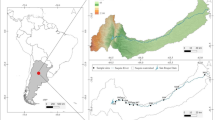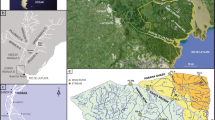Abstract
The EU Water Framework Directive 2000/60 (Integrated River Basin Management for Europe) establishes the importance of preserving water quality through policies applied at watershed level given the strong links existing among ecological, hydrological, and hydrogeological systems. Therefore, monitoring campaigns of river water quality should be planned with multidisciplinary approaches starting from a landscape perspective. In this paper, the effects of the basin hydrology on the river water quality and, in particular, the impacts caused by the runoff production coming from agricultural areas are investigated. The fluvial segments receiving consistent amount of pollutant loads (due to the runoff routing over agricultural areas) are assumed more critical in terms of water quality and thus, they require more accurate controls. Starting from this perspective, to evaluate the runoff productions coming from agricultural areas, we applied a semi-distributed hydrological model that adopts satellite data, pedological and morphological information for the watershed description. Then, the river segments receiving critical amount of runoff loads from the surrounding cultivated areas were identified. Finally, in order to validate the approach, water quality for critical and non critical segment was investigated seasonally, by using river macroinvertebrates as indicators of water quality because of their effectiveness in preserving in time a memory of pollution events. Biomonitoring data showed that river water quality strongly decreases in correspondence of fluvial segments receiving critical amount of runoff coming from agricultural areas. The results highlight the usefulness of such a methodology to plan monitoring campaigns specifically devoted to non-point pollution sources and suggest the possibility to use this approach for water quality management and for planning river restoration policies.
Similar content being viewed by others
References
APAT (2003) Metodologie analitiche per il controllo della qualità delle acque. National Environmental Protection Agency, Manuali e linee guida n. 29/2003, ISBN 88-448-0083-7 (In Italian).
Armitage, P. D., Moss, D., Wright, J. F., & Furse, M. T. (1983). The performance of a new biological water quality score system based on macroinvertebrates over a wide range of unpolluted running-water sites. Water Research, 17, 333–347.
ARPAB (2004). Censimento degli impianti di depurazione pubblici della Provincia di Potenza. Acerenza, PZ: Graphis snc, (In Italian).
Barbour, M. T., Gerritsen, J., Snyder, B. D., & Stribling, J. B. (1999). Rapid bioassessment protocols for use in streams and wadeable rivers: Periphyton, benthic macroinvertebrates and fish, second edition. Washington, D.C.: EPA 841-B-99-002. U.S. Environmental Protection Agency; Office of Water.
Beven, K., & O’Connel, P. E. (1982). On the role of distributed models in hydrology. Report 81. Wallingford, UK: Institute of Hydrology.
Brooks, A. J., Haeusler, T., Reinfelds, I., & Williams, S. (2005). Hydraulic microhabitats and the distribution of macroinvertebrate assemblages in riffles. Freshwater Biology, 50, 331–344.
Camporeale, C., & Ridolfi, L. (2006). Riparian vegetation distribution induced by river flow variability: A stochastic approach. Water Resources Research, 42, W10415, DOI 10.1029/2006WR004933.
Canivet, V., & Gibert, J. (2002). Sensitivity of epigean and hypogean freshwater macroinvertebrates to complex mixtures. Part I: Laboratory experiments. Chemosphere, 46, 999–1009.
Caricato, G., & Langella, M. (2006). La zona a Salmonidi del bacino del fiume Agri (Sud Italia): struttura, densità e biomassa delle popolazioni di trota fario, Salmo (trutta) trutta. Biologia Ambientale, 20(1), 135–140, (In Italian).
De Pauw, N., & Vanhoorenv, G. (1983). Method for biological quality assessment of watercourses in Belgium. Hydrobiologia, 100, 153–168.
Genito, D., Gburek, W. J., & Sharpley, A. N. (2002). Response of stream macroinvertebrates to agricultural land cover in a small watershed. Journal of Freshwater Ecology, 17(1), 109–119.
Ghetti, P. F. (2001). Manuale di Applicazione. Indice Biologico Esteso (I.B.E.). I macroinvertebrati nel controllo della qualità degli ambienti di acque correnti. (Provincia Autonoma di Trento). (In Italian).
Goethals, P., & De Pauw, N. (2001). Development of a concept for integrated ecological river assessment in Flanders, Belgium. Journal of Limnology, 60(1), 7–16.
He, C., Stephen, B. M., Kenneth, A. D., & Bojie, F. (2000). A conceptual framework for integrating hydrological and biological indicators into watershed management. Landscape and Urban Planning, 49, 25–34.
Iliopoulou-Georgudaki, J., Kantzaris, V., Katharios, P., Kaspiris, P., Georgiadis, Th., & Montesantou, B. (2003). An application of different bioindicators for assessing water quality: a case study in the rivers Alfeios and Pineios (Peloponnisos, Greece). Ecological Indicators, 2, 345–360.
Ingegnoli, V. (2002). Landscape ecology: A widening foundation. Berlin: Springer.
Isidori, M., Lavorgna, M., Nardelli, A., & Parrella, A. (2004). Integrated environmental assessment of Volturno River in South Italy. Science of the Total Environment, 327, 123–134.
Karr, J. R., & Chu, E. N. (1999). Restoring life in running waters. Better biological monitoring. USA: Island.
Kirkby, M. J. (1975). Hydrograph modelling strategies. In R. F. Peel, M. D. Chisholm, & P. Haggett (Eds.), Progress in physical and human geography (pp. 69–90). London: Heinemann.
León, L. F., Soulis, E. D., Kouwen, N., & Farquhar, G. J. (2001). Nonpoint source pollution: A distributed water quality modeling approach. Water Research, 35(4), 997–1007.
Liess, M., & Schulz, R. (1999). Linking insecticide contamination and population response in an agricultural stream. Environmental Toxicology and Chemistry, 18(9), 1948–1955.
Liu, Y. B. (1999). GIS-based spatially distributed hydrological modeling of the barebeek catchment. MSc. Dissertation Water Resources Engineering, Free University Brussels, Brussels, Belgium.
Mancini, L., Formichetti, P., D’Angelo, A. M., Pierdominici, E., Sorace, A., Bottoni, P., et al. (2005). Freshwater quality in urban areas: A case study from Rome, Italy. Microchemical Journal, 79(1–2), 177–183.
Manfreda, S., Iacobellis, V., & Fiorentino, M. (2004). Un esempio di Modellistica Integrata per l’Analisi dei Processi che Controllano la Frequenza delle Piene Fluviali. (Proceedings of the 29th Convegno di Idraulica e Costruzioni Idrauliche. Editoriale Bios Trento, Vol. 2: 463–70) (ISBN 88-7740-382-9). (In Italian).
Manfreda, S., Sdao, F., & Sole, A. (2007). Hydrogeological Water Balance in Carbonate Hydro-Structure. (Proceedings of 2nd IASWE/WSEAS International Conference on Water Resources, Hydraulics & Hydrology (WHH –7): 216–22) (ISBN: 978-960-8457-70-6).
Mayr, E. (1942). Systematics and the origin of species. New York: Columbia University Press.
Metcalfe, L. J. (1989). Biological water quality assessment of running waters based on macroinvertebrate communities: History and present status in Europe. Environmental Pollution, 60, 101–139.
Molnar, P., Burlando, P., & Ruf, W. (2002). Integrated catchment assessment of riverine landscape dynamics. Aquatic Sciences, 64, 129–140.
NWC (1981). River quality: The 1980 survey and future out-look. London: National Water Council.
Palmer, M. A., Swan, C. M., Nelson, K., Silver, P., & Alvestad, R. (2000). Streambed landscapes: Evidence that stream invertebrates respond to the type and spatial arrangement of patches. Landscape Ecology, 15, 563–576.
Petry, J., Soulsby, C., Malcolm, I. A., & Youngson, A. F. (2002). Hydrological controls on nutrient concentrations and fluxes in agricultural catchments. The Science of the Total Environment, 294, 95–110.
Preti, F. (1999). Overland transport of nitrate: algorithms validation. Water Science and Technology, 39(3), 77–92.
Richards, J. A. (1994). Remote sensing digital image analysis. Berlin: Springer.
Sasaky, A., Ito, A., Aizawa, J., & Umita, T. (2005). Influence of water and sediment quality on benthic biota in an acidified river. Water Research, 39, 2517–2526.
Schoonover, J. E., Williard, K. W. J., Zaczek, J. J., Mangun, J. C., & Carver, A. D. (2005). Nutrient attenuation in agricultural surface runoff by riparian buffer zones in Southern Illinois, USA. Agroforestry Systems, 64(2), 169–180.
Sponseller, R. A., Benfield, E. F., & Valett, H. M. (2001). Relationship between land use, spatial scale and stream macroinvertebrates communities. Freshwater Biology, 46, 1409–1424.
Stewart, J. S., Wang, L., Lyons, J., Horwatich, J. A., & Bannermann, R. (2001). Influences of watershed, riparian-corridor, and reach scale characteristics on aquatic biota in agricultural watersheds. Journal of the American Water Resources Association, 37(6), 1475–1487.
Thiere, G., & Schulz, R. (2004). Runoff-related agricultural impact in relation to macroinvertebrate communities of the Lourens River, South Africa. Water Research, 38, 3092–3102.
Tou, J. T., & Gonzalez, R. C. (1974). Pattern recognition principles. Massachusetts, Reading: Addison-Wesley.
Vannote, R. L., Minshall, G. W., Cummins, K. W., Sedell, J. R., & Cushing, C. E. (1980). The river continuum concept. Canadian Journal of Fisheries and Aquatic Sciences, 37, 130–137.
Ward, J. V., Tokner, K., Arscott, D. B., & Claret, C. (2002). Riverine landscape diversity. Freshwater Biology, 47, 517–539.
Weigel, B. M., Lyons, J., Paine, L. K., Dodson, S. I., & Undersander, D. J. (2000). Using stream macroinvertebrates to compare riparian land use practices on cattle farms in southwestern Wisconsin. Journal of Freshwater Ecology, 15(1), 93–106.
Whiles, M. R., Brock, B. L., Franzen, A. C., & Dinsmore, S. C. II (2000). Stream invertebrates communities, water quality, and land-use patterns in an agricultural drainage basin of Northeastern Nebraska, USA. Environmental Management, 26(5), 563–576.
Wijngaarden, R. P. A., Van Brock, T. C. M., & Van Den Brink, P. J. (2005). Threshold levels for effects of insecticides in freshwater ecosystems: A review. Ecotoxicology, 14, 355–380.
Woodiwiss, F. S. (1964). The biological system of stream classification used by the Trent River Board. Chemistry and Industry, 14, 443–447.
Wright, J. F., Moss, B., Armitage, P. D., & Furse, M. T. (1984). A preliminary classification of running-water sites in Great Britain based on macro-invertebrate species and the prediction of community type using environmental data. Freshwater Biology, 14, 221–256.
Zalewski, M., & Roberts, R. (2003). Ecohydrology—A new paradigm for integrated water resources management. SILnews, 40, 1–5.
Author information
Authors and Affiliations
Corresponding author
Rights and permissions
About this article
Cite this article
Carone, M.T., Simoniello, T., Manfreda, S. et al. Watershed influence on fluvial ecosystems: an integrated methodology for river water quality management. Environ Monit Assess 152, 327–342 (2009). https://doi.org/10.1007/s10661-008-0319-1
Received:
Accepted:
Published:
Issue Date:
DOI: https://doi.org/10.1007/s10661-008-0319-1




